Athanadoros, Hagesandros, and Polydoros of Rhodes, Laocoön and his Sons, early first century C.E., marble, 7’10 1/2″ high (Vatican Museums); speakers: Dr. Beth Harris and Dr. Steven Zucker

Athanadoros, Hagesandros, and Polydoros of Rhodes, Laocoön and his Sons, early first century C.E., marble, 7’10 1/2″ high (Vatican Museums; photo: Steven Zucker, CC BY-NC-SA 2.0)
The sculptural group known today as the Laocoön or Laocoön and his Sons has been both one of the most influential ancient artworks in the history of art and one of the most fiercely debated. It has been copied by countless artists, and numerous books have been written about it, yet there is still little scholarly consensus about the circumstances of its creation.
The statue was discovered in 1506 on the Esquiline Hill in Rome by a farmer working in his vineyard. The Laocoön was only one of a number of ancient artworks that had been abandoned, forgotten, and eventually buried under later buildings and streets. During the Renaissance, a number of these artworks were rediscovered, either accidentally during construction projects or purposefully by people hunting for the artworks which had become greatly admired. One of the first people to see the statue was Michelangelo, who was sent by the pope, Julius II, along with architect Guiliano da Sangallo, to inspect the statue after its excavation. Julius, like many of his sixteenth-century Italian contemporaries, was a connoisseur and collector of ancient Greek and Roman art. He purchased the statue, and it has remained in the collection of the Vatican ever since.
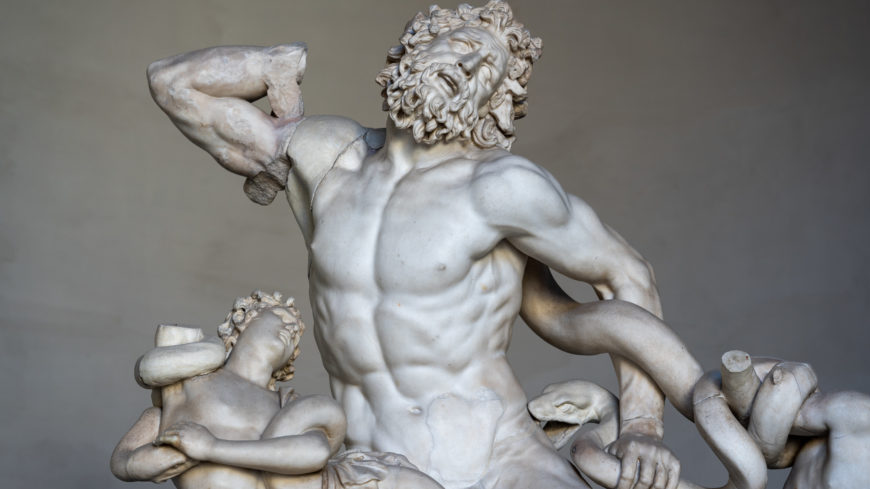
Athanadoros, Hagesandros, and Polydoros of Rhodes, Laocoön and his Sons, early first century C.E., marble, 7’10 1/2″ high (Vatican Museums; photo: Steven Zucker, CC BY-NC-SA 2.0)
Most likely dating to the first century B.C.E. or first century C.E., the statue is made of six blocks of Greek Parian marble. It is over-life sized, at a height of 6’ 8”. The composition depicts the tortuous death of Laocoön and his two sons by snakes (read the full story below). All three are nude with clearly defined, exaggerated musculature. Bands of clenched muscles are visible under the skin of Laocoön’s torso as he reaches up to fight off the snakes. The statue, like all ancient Greek and Roman marble sculptures, would have been painted originally. The bright green of the twisting snakes and the red blood drawn by their bites would have stood out against the tan flesh of Laocoön and his sons.
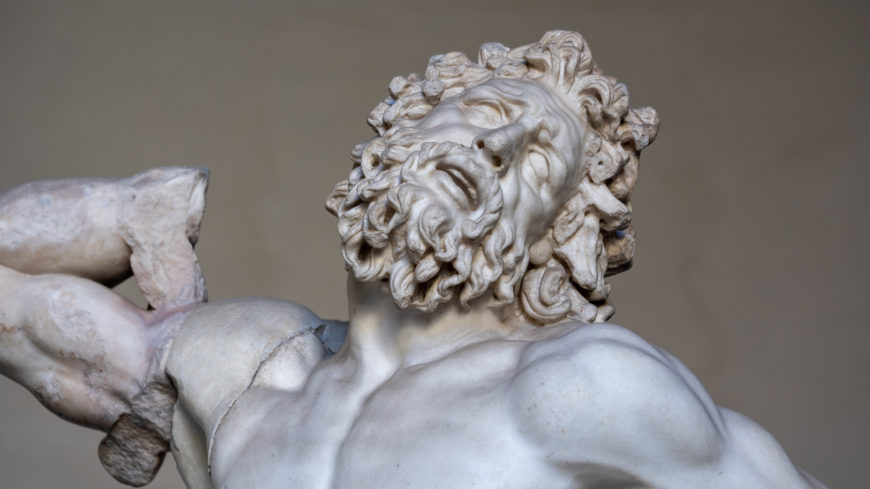
Athanadoros, Hagesandros, and Polydoros of Rhodes, Laocoön and his Sons, early first century C.E., marble, 7’10 1/2″ high (Vatican Museums; photo: Steven Zucker, CC BY-NC-SA 2.0)
Laocoön is at the center of the composition, sitting in a twisted position on an altar. One snake sinks its teeth into his hip. Laocoön throws his head back as he screams in agony. His hair and beard curl in deeply carved locks, contributing to the sculpture’s dramatic tone. Based on surviving paint on his eyes, some scholars have argued that he has been blinded by the bites of the snakes.
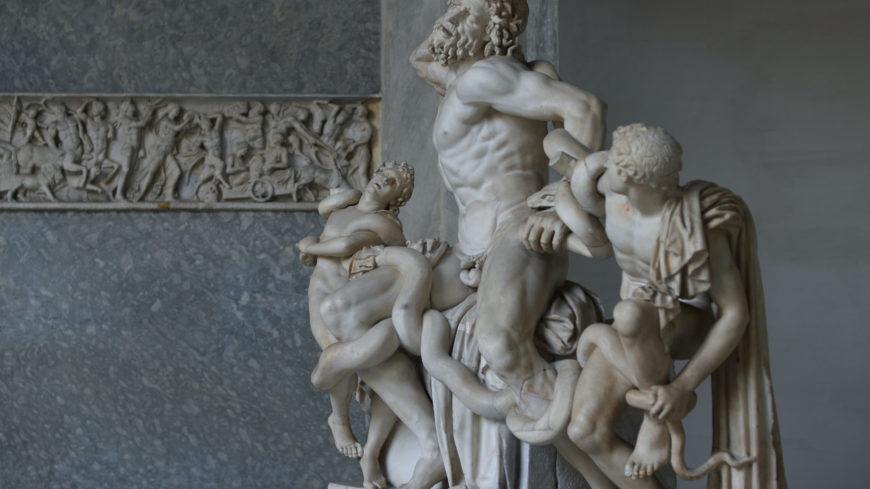
Athanadoros, Hagesandros, and Polydoros of Rhodes, Laocoön and his Sons, early first century C.E., marble, 7’10 1/2″ high (Vatican Museums; photo: Steven Zucker, CC BY-NC-SA 2.0)
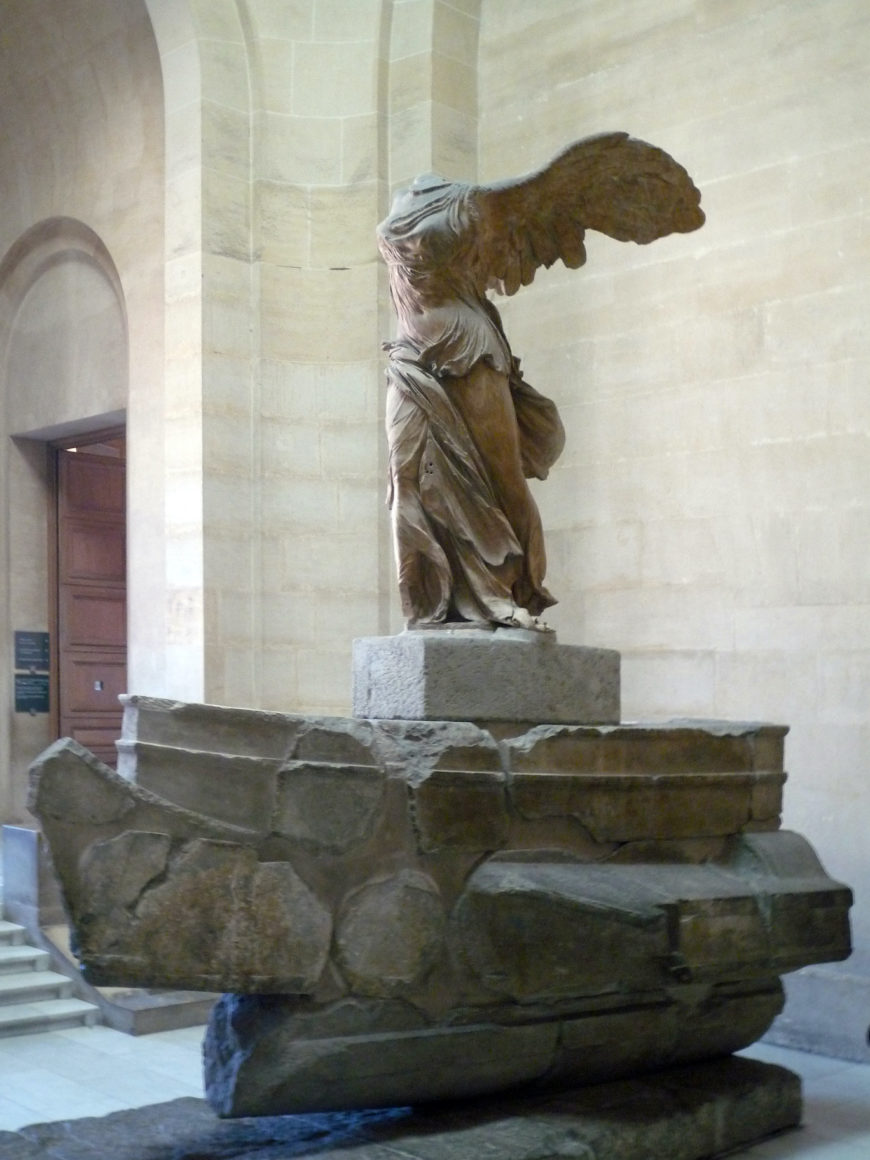
Nike of Samothrace (winged Victory), Lartos marble (ship), Parian marble (figure), c. 190 B.C.E., 3.28 meters high (Louvre, Paris; photo: Steven Zucker, CC BY-NC-SA 2.0)
Laocoön is flanked by his two teenaged sons. The figure on the left, the younger of the two, has gone limp, and it is likely that he is already dead. The older son, on the right, pulls snake coils off his leg and arm. He turns to look at his father, an expression of horror and confusion on his face. With its emphasis on theatricality and exaggerated realism, it is similar to artworks of the so-called Hellenistic baroque, such as the Nike of Samothrace and the Great Altar at Pergamon. While the style is most closely associated with the city of Pergamon and the island Rhodes in the second century B.C.E., Hellenistic baroque had an enduring popularity, and artworks in the style continued to be produced into the Roman Imperial period, with Rome becoming a center of Hellenistic art.
The Story of Laocoön
The myth of Laocoön dates back to the seventh century B.C.E. It was part of the Epic Cycle, a series of poems that told the story of the Trojan War (Greeks against the city of Troy, in present-day Turkey). Today, only the Iliad and the Odyssey survive, but we have fragments or descriptions of the other volumes. Laocoön appeared in the now-lost Ilioupersis (the sack of Troy) by Arktinos of Miletos. Versions of Laocoön’s story appeared after that, notably in a now-lost fifth century B.C.E. play of Sophocles.
The version closest chronologically to the Laocoön statue appeared in Roman writer Vergil’s Aeneid, published in 19 B.C.E. The Aeneid tells the story of the Trojan warrior Aeneas who escapes from Troy during its destruction and makes his way to Italy, where he rules over the Latin people. The story of Laocoön forms part of book two, which recounts the sack of Troy. The Greeks pretended to give up their siege of Troy with its unbreakable walls, leaving only a large wooden horse as a final offering to the gods. In actuality, some hid out of sight while others hid inside the horse. Only a few Trojans spoke against bringing the horse inside the city. The first was Cassandra, who was blessed with the gift of prophecy, but cursed that no one would ever believe her. The other was Laocoön, a priest of Neptune (Greek Poseidon). He warned the Trojans with his now famous line, “I fear the Greeks, even when they bring gifts.” But the gods had decided the Greeks were to win the war, and no one, divine or mortal, can defy fate. So the gods sent a pair of snakes to silence Laocoön. They came from the sea, attacking Laocoön and his sons while he made a sacrifice. They bit and wrapped themselves around the three, killing first the sons and then Laocoön. This is the moment represented in the marble statue.
Trojan war stories were popular in ancient Rome, especially during the reigns of the Julio-Claudian emperors (27 B.C.E.–68 C.E.). The myths connected the Romans back to the ancient and revered past, giving them legitimacy as a cultural and military power through these connections. The Julian family traced their lineage directly back to the Trojan warrior Aeneas, and so actively promoted art and literature like the Aeneid that focused on Troy.
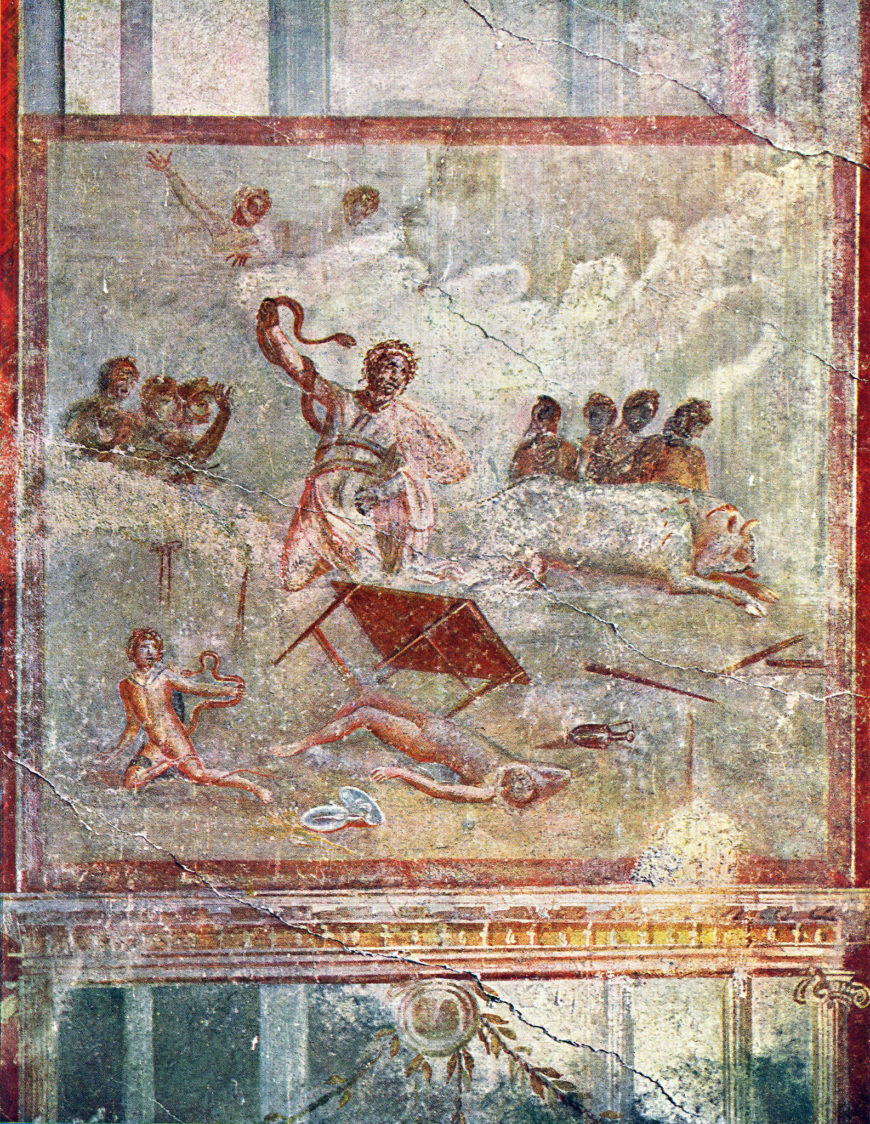
Scene showing Laocoön, 1st century C.E., atrium of the House of Menandro, Pompeii (Wikimedia CC BY-SA 3.0)
While Laocoön was a recurring subject in texts, he was not as popular in art. Images of Laocoön have been identified on a few pots made by south Italian Greeks in the fourth century B.C.E., but most of the known images are Roman. Gems dating to the late imperial period as well as two first-century C.E. paintings from houses in Pompeii depict the death of Laocoön. Artworks are few, however, and the marble statue is the only monumental depiction of the subject to survive.
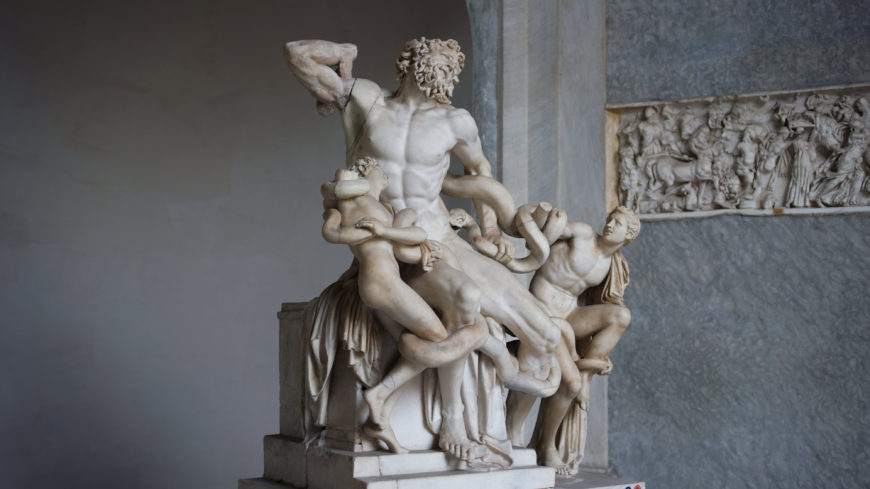
Athanadoros, Hagesandros, and Polydoros of Rhodes, Laocoön and his Sons, early first century C.E., marble, 7’10 1/2″ high (Vatican Museums; photo: Steven Zucker, CC BY-NC-SA 2.0)
Pliny and The Laocoön
The Laocoön is fairly unusual among surviving ancient artworks because it is described in an ancient text, Natural History, by Pliny the Elder. Most of the famous artworks described by ancient authors have been lost and those artworks that have survived are without ancient textual description.
Pliny, a Roman aristocrat and scholar, published the first volumes of The Natural History in 77 C.E. This encyclopedia was intended to record all known knowledge. In his discussion of famous statues, Pliny describes the Laocoön as he saw it in the house of the ancient Roman emperor Titus, and attributes it to the artists Hagesandros, Polydoros, and Athenodoros of Rhodes. Pliny praises the statue as superior to all other artworks. Despite some inconsistencies between the Laocoön statue and Pliny’s description, notably the statue is made of multiple blocks of stone rather than a single block as Pliny says, it is widely accepted that the Laocoön in the Vatican is the statue described by Pliny.
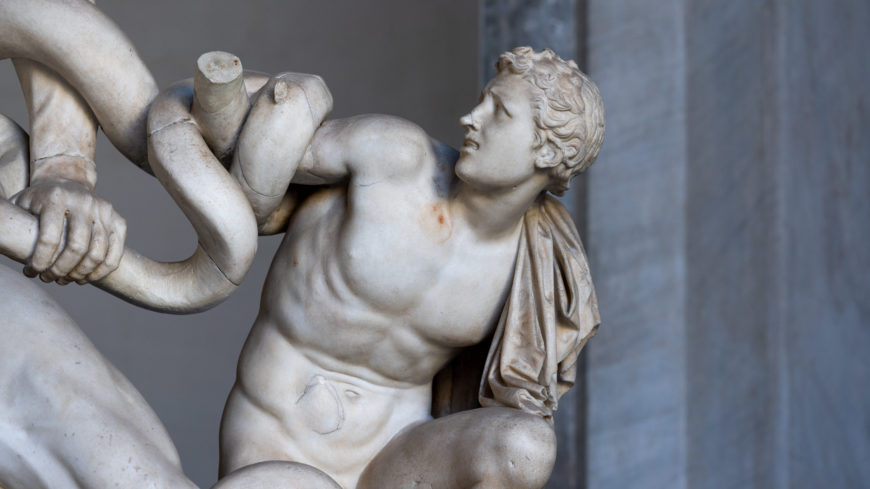
Athanadoros, Hagesandros, and Polydoros of Rhodes, Laocoön and his Sons, early first century C.E., marble, 7’10 1/2″ high (Vatican Museums; photo: Steven Zucker, CC BY-NC-SA 2.0)
Dating the Laocoön
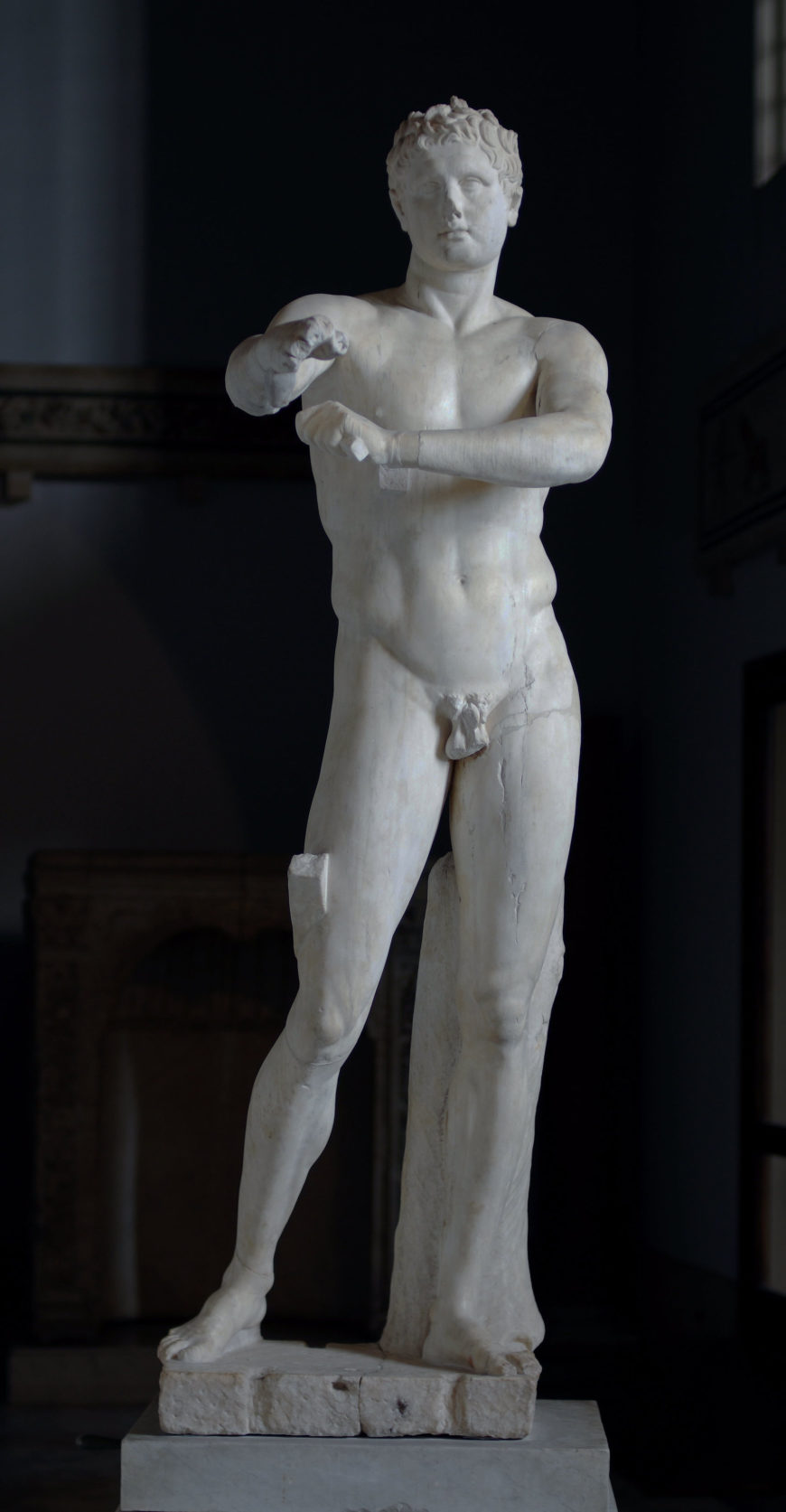
Another example of a Greek sculpture that was brought back to Rome, then copied. Lysippos, Apoxyomenos (Scraper), Roman copy after a Greek bronze statue from c. 330 B.C.E., 6′ 9″ high (Vatican Museums)
The circumstances surrounding the creation of the Laocoön, including its date, have been long debated by scholars. While one scholar proposed that the statue was actually a Renaissance forgery by Michelangelo, this theory has been widely discredited, and most scholars date the statue between 150 B.C.E. and 70 C.E. Each of these proposals examine why a statue in the Hellenistic Greek style was found in Rome, and the role of Romans as patrons and collectors of Greek sculpture.
The Romans, especially in the late Republic and early Empire, were active connoisseurs of Greek art. As they conquered Greek territories, they imported large numbers of Greek artworks to Italy, removing them from homes, public buildings, and sanctuaries. Romans displayed Greek artworks in their homes and public spaces, many in contexts far removed from their original locations and purposes. These artworks took on new meanings as symbols of the wealth and education of their owners. The Romans also commissioned copies of famous statues as well as new compositions inspired by Greek originals. Rome became a center of Hellenistic art as Greek artists moved to Italy to work for wealthy Romans.
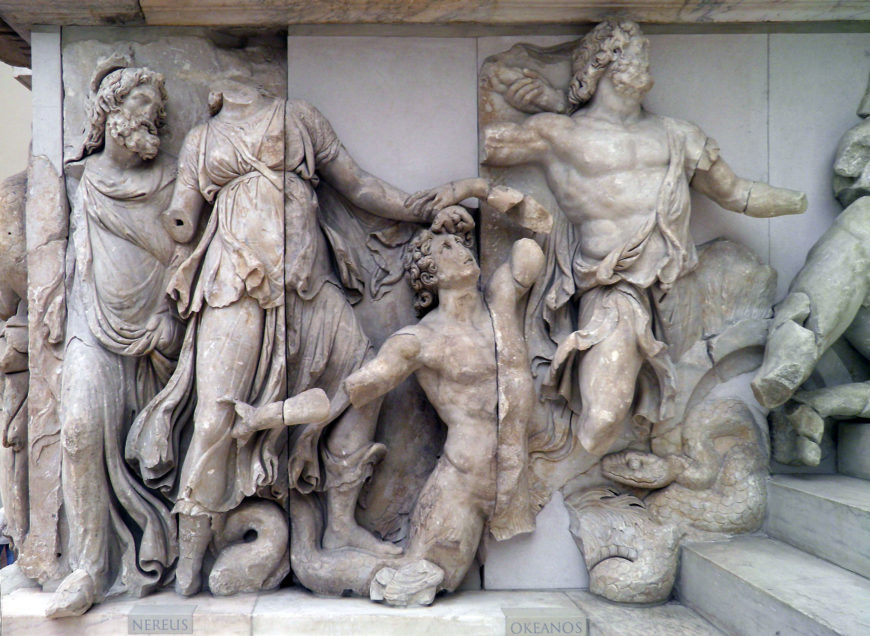
North side of grand staircase, Pergamon Altar (photo: Carole Raddato, CC BY-SA 2.0)
Theories that posit the earliest date for the Laocoön propose that, based on stylistic similarities, the Laocoön is contemporary to the second-century B.C.E. Great Altar at Pergamon and that it was made in the Greek island of Rhodes before being exported to Rome. Other scholars propose that the marble statue found in Rome was a copy of an earlier second-century Greek original. Most writers, however, argue that the Laocoön was made in Rome for Roman patrons.
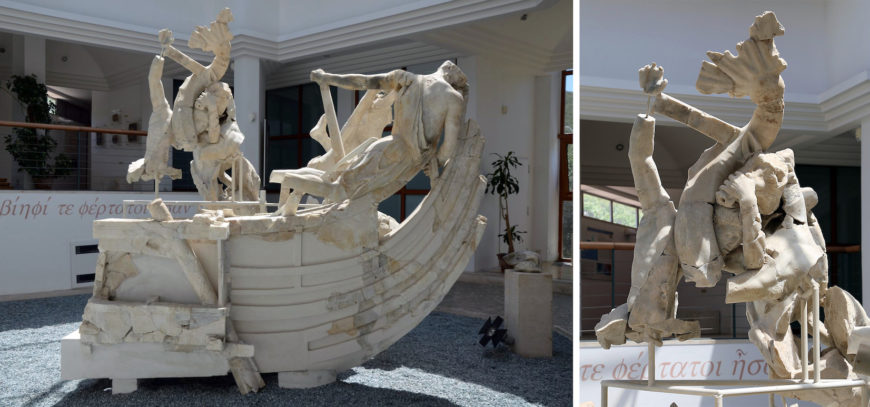
Part of the Skylla group, 1st century B.C.E.–1st century C.E., marble, Sperlonga (left photo: Carole Raddato, CC BY-SA 2.0; right photo: Sailko, CC BY 3.0)
Support for a Roman context for the creation of the statue comes from the site of Sperlonga, located between Rome and Naples. Here, the emperor Tiberius had a grotto for dining and entertainment decorated with monumental marble statues. The statues are over-life sized and depict scenes from the Trojan war or the life of Odysseus. They are in the same dramatic, hyper-realistic style as the Laocoön, and an artist’s signature was found on the sculptural group that depicted Odysseus’ run-in with the sea monster, Skylla attributing the statues to Hagesandros, Athenadoros, and Polydoros of Rhodes—the same artists to whom Pliny attributes the Laocoön. Debates over the creation of the Laocoön statue are therefore intertwined with the Sperlonga statues.
Most recent scholarly discussions have centered on whether the sculptures were made specifically for the grotto and Titus’s palace or whether they were made earlier and moved to these locations. While there is still no definitive consensus, most scholars now place both the Sperlonga statues and the Laocoön in the first century B.C.E. or first century C.E. Their dramatic, Hellenistic style, along with the focus on Trojan war themes place them in line with the concerns of upper-class Roman patrons in these periods.

Athanadoros, Hagesandros, and Polydoros of Rhodes, Laocoön and his Sons, early first century C.E., marble, 7’10 1/2″ high (Vatican Museums; photo: Steven Zucker, CC BY-NC-SA 2.0)
An unquestionable legacy
From Pliny to Michelangelo to modern visitors to the Vatican Museums, the Laocoön statue has made an impact on its viewers. Its dramatic depiction of the agony of Laocoön and his sons forges an emotional connection with its audience. While scholars continue to debate how and when it was created and its ancient context, its legacy is unquestionable.
Additional resources:
Laocoön at the Vatican Museums
Digital Sculpture Project: Laocoön
Richard Brilliant, My Laocoön: Alternative Claims in the Interpretation of Artworks (Berkeley: University of California Press, 2000).
Lynn Catterson, “Michelangelo’s ‘Laocoön?’” Artibus et Historiae vol. 26, no. 52 (2005), pp. 29–56.
Seymour Howard, “Laocoon Restored,” American Journal of Archaeology vol. 93, no. 3 (1989), pp. 417–22.
Brunilde Sismondo Ridgway, Hellenistic Sculpture III: The Styles of c. 100–31 B.C. (Madison: University of Wisconsin Press, 2002), pp. 87–90.
Andrew Stewart, “Baroque Classics: The Tragic Muse and the Exemplum,” in Classical Pasts: The Classical Traditions of Greece and Rome. Edited by James I. Porter (Princeton: Princeton University Press, 2006), pp. 127–55.
Andrew Stewart, “To Entertain an Emperor: Sperlonga, Laokoon and Tiberius at the Dinner-Table,” The Journal of Roman Studies vol. 67 (1977), pp. 76–90.
Smarthistory images for teaching and learning:
[flickr_tags user_id=”82032880@N00″ tags=”Laocoön,”]

